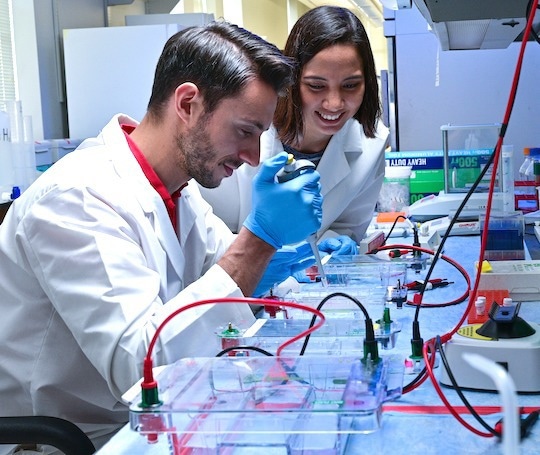In the quest for antibiotics to address the increasing issue of resistance in disease treatment, silence may be the best policy.
 Rice graduate students Andrea Ameruoso and Maria Claudia Villegas Kcam prepare DNA for an experiment to target “silent” genes in a strain of bacteria that show potential for developing new antibiotics. Image Credit: Jeff Fitlow.
Rice graduate students Andrea Ameruoso and Maria Claudia Villegas Kcam prepare DNA for an experiment to target “silent” genes in a strain of bacteria that show potential for developing new antibiotics. Image Credit: Jeff Fitlow.
Bioscientists at Rice University have created brand-new on/off switches to manage the “silent” genes in a particular strain of bacteria. Their approach could accelerate the never-ending quest for new antibiotics.
To control the expression of genes in Streptomyces bacteria that are normally only expressed when essential, the researchers modified CRISPR tools. It has been difficult for synthetic biologists to access those genes up until now.
As labs started to sequence the genomes of these organisms that were known to produce one or a few antibiotics, we realized that the pathways responsible for the production of antibiotic and other molecules of interest are much more abundant than previously thought. Each Streptomyces strain is now predicted to be able to produce up to 40 different molecules of interest, including antibiotics, on average.”
James Chappell, Assistant Professor, Department of Biosciences, Rice University
Chappell’s laboratory investigates how to manipulate bacteria.
Chappell and doctoral student Andrea Ameruoso’s work may make it feasible for laboratories to swiftly create libraries of potential antibiotics to test against pathogens. Researchers made a point of pointing out that although CRISPR-Cas9 has been used to build a platform to trigger genes in organisms like Escherichia coli, this is the first time it has been utilized on Streptomyces.
The study was published in the journal Nucleic Acids Research.
Bacteria such as Streptomyces have evolved to only produce antibiotics when they need to, in natural environments like soil. When we grow them in the lab, it’s an artificial environment and very different to how they naturally grow, so sets of genes are silenced. They’re a kind of genetic dark matter. We can’t isolate the chemicals they express to perform a functional screen.”
James Chappell, Assistant Professor, Department of Biosciences, Rice University
With their novel approach, the researchers can do away with the time-consuming chore of exposing S. Venezuela, the bacteria that produces the common antibiotic chloramphenicol, to possible gene-expression triggers. “Andrea’s technology adds synthetic regulators into the cell to artificially stimulate or repress the expression of these pathways,” Chappell noted.
“Now we just need one protein and one small piece of RNA and we can go wherever we want to directly repress or activate a given target,” Ameruoso stated.
According to Ameruoso, access to the previously undiscovered gene clusters was made easier by the development of CRISPR technology, which modifies bacterial immune system processes to pinpoint certain genes along a strand of DNA.
Streptomyces is a genus of bacteria that encompasses up to 500 species, and each species can have between 20 and 40 of these clusters of genes able to produce antibiotics or other molecules of interest. So once we figure out a way to scale up our technology, it can be incredibly powerful.”
Andrea Ameruoso, Doctoral Student, Department of BioSciences, Rice University
According to Chappell, designing CRISPR to attach to various DNA sequences is a simple process. “We exploit that for gene expression control. If we want to do this in a bunch of different species on a bunch of different pathways, it should in theory be possible. So this paper lays the foundation for a new type of approach,” Chappell said.
Ameruoso said that he is developing a fluorescent method to watch cluster activation in real-time. Ameruoso also added, “The main challenge is that observing the depths of the activation of a cluster relies on the purification of the molecule from the extracts we generate. That’s a low-throughput process that requires a lot of work. We want to develop a reporter to observe a fluorescent signal when a pathway is being activated.”
The approach might be utilized to create compounds for antifungal and anticancer drugs as well as for agriculture, according to the researchers. Chappell explained, “We focus on antibiotics because at some point in history, we’ve observed that they kill microbes. But that’s not necessarily what they evolved for, because they’re also frequently used as communication signals between cells. So there are many potential uses.”
Chappell said that the work presents a crucially new method for triggering dormant circuits. “The vision for the next generation of the work is to go big. We showed it works on a single silent pathway. Now let’s do it on the 40 pathways in this one species, and then let’s do it on thousands of microbes. The power of CRISPR-Cas9 is that it’s really scalable for that,” Chappell concluded.
Source:
Journal reference:
Ameruoso, A., et al. (2022) Activating natural product synthesis using CRISPR interference and activation systems in Streptomyces. Nucleic Acids Research. doi.org/10.1093/nar/gkac556.